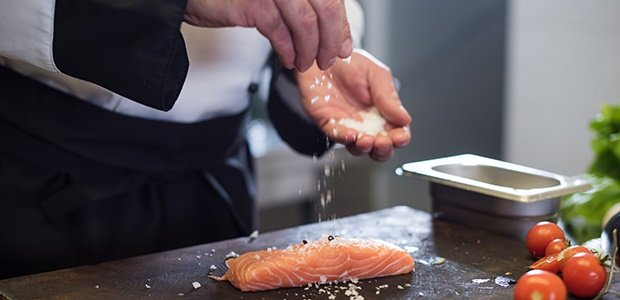In a NY Times article entitled ‘The Single Most Important Ingredient‘, writer and cook Samin Nosrat sizes up the importance of salt. Not just a granule form in a shaker on the dining room table, salt plays a pivotal – if not the pivotal – role in a successful dish. Too little or too much salt can make or break a dish’s flavour. “Most often, when a dish fell flat, the answer lay in adjusting the salt,” says Nosrat of her kitchen experiences. “Sometimes it was in the form of salt crystals, but other times it meant a grating of cheese, some pounded anchovies, a few olives or a sprinkling of capers. I began to see that there was no better guide in the kitchen than thoughtful tasting, and that nothing was more important to taste thoughtfully than salt.”
Samin has taught everyone from professional chefs to middle school children to famous authors to cook using her revolutionary, yet simple, philosophy. Master the use of just four elements — salt, which enhances flavour; fat, which delivers flavour and generates texture; acid, which balances flavour; and heat, which ultimately determines the texture of food. “Her book ‘Salt Fat Acid Heat‘ not only teaches you how to cook, but captures how it should feel to cook: exploration, spontaneity and joy,” says Alice Waters, chef, author, and founder of Chez Panisse.
Salt may have a bad rep for the health conscious, but inspired by Samin’s appreciation for this sodium chloride composite, we break down salt: a well-loved yet oft underrated flavour.
What is Salt?
Salt, or sodium chloride, is an essential mineral and nutrient that the human body cannot make itself. From nerve and muscle functioning to regulating our body’s water content, we in fact cannot live without salt. Food scientist Harold McGee shares in his “The Mind of a Chef” series the wonders of salt: Salt is by far the most used seasoning in almost every style of cooking. It’s a magical ingredient in that it interplays with our five basic tastes – sweet, sour, bitter, umami, and salt itself.
Salt = Flavour
All cooks and bakers know salt plays an important role in cooking — even a little pinch can change a dish. The flavours of caramel, chocolate, and even fruit are enhanced by a sprinkling of salt; while, as part of a brine or rub, salt tenderizes meat and infuses it with flavour.
What most people don’t know is that when adding sodium to food, aromas can be affected too – it can even suppress bitterness.
ALSO READ: Make delicious salt and pepper calamari at home
Types of Salt:
Table salt
Table salt is generally mined from underground salt deposits. It’s heavily processed in order to eliminate minerals and usually contains an additive to prevent clumping. Most table salt also has added iodine, an essential nutrient that helps maintain a healthy thyroid (via mayoclinic.org).
Sea salt
Sea salt is produced through evaporation of ocean water or water from saltwater lakes, and usually involves little processing. Depending on the water source, this leaves behind certain trace minerals and elements. The minerals add flavour and colour to sea salt, which also comes in various coarseness levels (via mayoclinic.org).
Himalayan salt
Himalayan salt, also known as Himalayan crystal salt, is a type of rock salt known for its pink colour, which comes from the natural presence of several trace minerals including magnesium and iodine. Himalayan salt is unrefined and hand-mined from caves in northern Pakistan. Because it’s millions of years old and has been left untouched, many people believe that Himalayan crystal salt is a better option than standard table salt, which, as mentioned above, often contain toxins and pollutants as a result of heavy processes (via globalhealingcenter.com).
image: iStock
Cooking with Salt
More than 75% of salt ingested by humans comes from restaurants, prepackaged, and processed foods, including many products that don’t even taste salty. Using salt at home in moderation can help monitor your sodium intake — despite how well we respond to savoury flavours this shouldn’t be excessive. The role of sodium in cooking is multi-part: it enhances flavour, preserves freshness and improves texture and appearance.
Use this four-step guide to cooking with salt:
1. Season along all stages of the cooking process (not just the end) and taste as you go.
2. Avoid seasoning when adding naturally salty ingredients, such as bacon or capers.
3. Foods will develop flavour as they cook – keep this in mind as saltiness can change as temperature changes, or can concentrate as liquids reduce. Again: taste as you go.
4. And, we mean this earnestly – salt bae got it right – practice salting food at a height of about 25 to 30cm (length of a ruler) above the food. This gives a better sense of how much salt you’re using.
#saltbae
ALSO READ: Satisfy your sweet tooth with this buttermilk and salted caramel coma malt cake
images and recipe: The Kate Tin
When is too much too much?
Our bodies require only a small amount of sodium each day to function normally. Eating too much salt can lead to increased blood pressure, which offers its own risks. Use salt carefully and in moderation, but never take the power of its ionic compound for granted – it may just make or break your menu.
Be it Himalayan or regular table salt or even fancy fleur de sel – the most basic salt will do its bit to heighten flavour. We can bet your salt on it.

